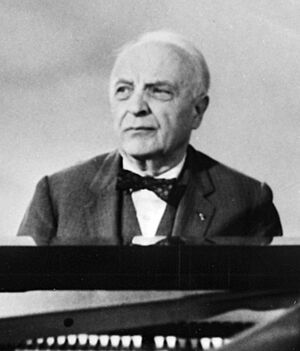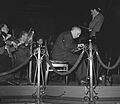Robert Casadesus facts for kids
Quick facts for kids
Robert Casadesus
|
|
|---|---|

Casadesus performing in 1972
|
|
| Born | 7 April 1899 Paris, France
|
| Died | 19 September 1972 (aged 73) Paris, France
|
| Occupation |
|
Robert Marcel Casadesus (born April 7, 1899 – died September 19, 1972) was a famous French pianist and composer in the 20th century. He was the most well-known member of a talented musical family. His uncles were Henri Casadesus and Marius Casadesus. He was married to Gaby Casadesus and was the father of Jean Casadesus.
Contents
About Robert Casadesus
Robert Casadesus was born in Paris, France. He studied music at the Conservatoire, a famous music school in Paris. He won a "Premier Prix" (First Prize) in 1913 and the "Prix Diémer" in 1920. These were important awards for young musicians.
Later, he joined the class of Lucien Capet. Capet was a big influence on Robert. Lucien Capet had a famous music group called the Capet Quartet. Robert's uncles, Henri and Marcel, played in this quartet. Because the quartet often practiced at the Casadesus home, Robert grew up listening to and learning about chamber music. He knew the famous Beethoven Quartets very well.
Starting in 1922, Robert Casadesus worked with the composer Maurice Ravel. They made piano rolls of Ravel's music. Piano rolls were like early recordings that could play music on a special piano. Casadesus and Ravel also performed concerts together in France, Spain, and England. Robert traveled a lot as a solo pianist. He also often performed with his wife, Gaby (L'Hôte) Casadesus, who was also a pianist. They got married in 1921.
From 1935, Casadesus taught at the American Conservatory in Fontainebleau, France. During World War II, he and his family lived in the United States. They had a home in Princeton, New Jersey. One of their neighbors in Princeton was Albert Einstein, a famous scientist who played the violin for fun. Robert and Albert sometimes played Mozart's music together privately.
After France was taken over in 1940, Robert and Gaby started the Fontainebleau School in Newport, Rhode Island. In 1942, the school moved to Great Barrington, Massachusetts. In 1943, Robert performed in New York concerts to help raise money for French relief groups.
After the war, in 1946, Robert Casadesus became the Director of the American Conservatory. He helped move the school back to Fontainebleau, France. Many students learned from him, including Claude Helffer, Grant Johannesen, and Monique Haas. He kept making recordings and composing music. His last composition was Symphony No. 7, called "Israel." It was a tribute to the people of Israel. He dedicated it to his friend and conductor George Szell. Szell died in 1970, the same year the music was finished. The symphony was first performed shortly after Casadesus died in 1972.
Robert and Gaby Casadesus had three children: Jean, Guy, and Therese. Robert Casadesus passed away in Paris on September 19, 1972, after a short illness. This was only a few months after his son Jean died in a car accident. Gaby Casadesus died in Paris on November 12, 1999. In her later years, she helped prepare Ravel's music for publication.
His Musical Style
Robert Casadesus was known for his "French pianism" style. This means his playing was clear, balanced, and precise. He had a very gentle way of playing melodies. He was especially famous for playing the music of Wolfgang Amadeus Mozart.
He also recorded all of the piano music by Maurice Ravel. For these recordings, he won important awards like the Grand Prix de l'Academie Charles Cros. He also recorded Beethoven's Violin Sonatas with Zino Francescatti. One of these, the Kreutzer Sonata, was even filmed and released on DVD. In 1967, a TV show called The Bell Telephone Hour made a special film about Robert, Gaby, and their son Jean. It was called "The First Family of the Piano."
His Recordings
Casadesus was especially famous for his recordings of Mozart's piano concertos. He recorded Mozart's Piano Concerto No. 27 in 1941. Later, he made many recordings of Mozart's piano concertos with George Szell and the Cleveland Orchestra. He often used his own special musical parts called "cadenzas" in these recordings.
He also recorded Mozart's concertos for two and three pianos. For these, his wife Gaby and son Jean joined him. The Philadelphia Orchestra played with them, led by Eugene Ormandy. These recordings are still available today.
He also recorded music by Johann Sebastian Bach for two and three keyboards. He recorded some of Beethoven's piano concertos and sonatas. He often recorded Beethoven's violin and piano sonatas with Zino Francescatti.
Casadesus was also known for recording French music by composers like Rameau, Chabrier, Fauré, Debussy, and Ravel. In 1951, he made the first complete recording of all of Ravel's solo piano music. He also recorded French music for four hands and two pianos with his wife Gaby.
His recordings also include music by Scarlatti, Schubert, Schumann, and Chopin. He also recorded some of his own compositions.
What Critics Said
Music expert David Dubal wrote that Robert Casadesus was "the absolute French pianist, his country's finest." Dubal said that Casadesus showed the best qualities of French music: balance, clear sound, style, and exact technique. His playing was described as "crisp, dry, and sparkling, like a vintage champagne." Casadesus was a very skilled musician with amazing control over the piano.
His Compositions
Robert Casadesus wrote many pieces of music. Here are some of them:
Music for Orchestra
- Suite No. 1, Op. 11 (1927)
- Symphony No. 1 in D major, Op. 19 (1934)
- Symphony No. 2, Op. 32 (1941)
- Symphony No. 3, Op. 41 (1947)
- Symphony No. 4, Op. 50 (1954)
- Symphony No. 5 "on the Name of [[Joseph Haydn|Haydn]", Op. 60 (1959)
- Symphony No. 6, Op. 66 (1965)
- Symphony No. 7 for chorus and orchestra, "Israel," Op. 68 (1967–70)
Concertos (Music for Solo Instrument and Orchestra)
- Concerto No. 1 for piano and orchestra, Op. 7 (1926)
- Concerto for violin and orchestra, Op. 15 (1931)
- Concerto for 2 pianos and orchestra, Op. 17 (1933)
- Concerto for flute and chamber orchestra, Op. 35 (1942)
- Concerto No. 2 for piano and orchestra, Op. 37 (1944)
- Concerto for cello and orchestra, Op. 43 (1947)
- Concerto No. 3 for piano and orchestra, Op. 63 (1961)
- Concerto for 3 pianos and string orchestra, Op. 65 (1964)
Chamber Music (Music for Small Groups of Instruments)
- Piano Trio No. 1, Op. 6 (1924)
- Sonata No. 1 for violin and piano, Op. 9 (1927)
- Quintet for flute, violin, viola, cello and harp, Op. 10 (1927)
- Sonata for viola and piano, Op. 12 (1928)
- String Quartet No. 1, Op. 13 (1929)
- Piano Quintet in D minor, Op. 16 (1932)
- Sonata for flute and piano, Op. 18 (1934)
- Sonata for cello and piano, Op. 22 (1935)
- Sonata for oboe (or clarinet) and piano, Op. 23 (1936)
- String Quartet No. 2, Op. 29 (1940)
- Piano Quartet, Op. 30 (1940)
- Sonata No. 2 for violin and piano, Op. 34 (1942)
- String Quartet No. 3, Op. 46 (1950)
- Piano Trio No. 2, Op. 53 (1956)
- String Quartet No. 4, Op. 55 (1957)
Piano Music
- Le voyage imaginaire (The Imaginary Trip), Op. 1 (1916)
- Six pièces (6 Pieces) for 2 pianos, Op. 2 (1920)
- Vingt-quatre préludes (24 Preludes), Op. 5 (1924)
- Sonata No. 1, Op. 14 (1930)
- Huit études (8 Etudes), Op. 28 (1939)
- Sonata No. 2, Op. 31 (1941)
- Trois danses méditerranéennes (3 Mediterranean Dances) for 2 pianos, Op. 36 (1943)
- Chant pour la libération de Paris (Song for the Liberation of Paris) for 2 pianos, Op. 38 (1944)
- Toccata, Op. 40 (1946)
- Sonata No. 3, Op. 44 (1948)
- Sonata No. 4, Op. 56 (1957)
- Sonata for 2 pianos, Op. 62 (1960)
Vocal Music
- Spleen for voice and orchestra, Op.3 (1923)
- Trois rondels pour après for voice and piano, Op. 21 (1935)
Images for kids
See also
 In Spanish: Robert Casadesus para niños
In Spanish: Robert Casadesus para niños



